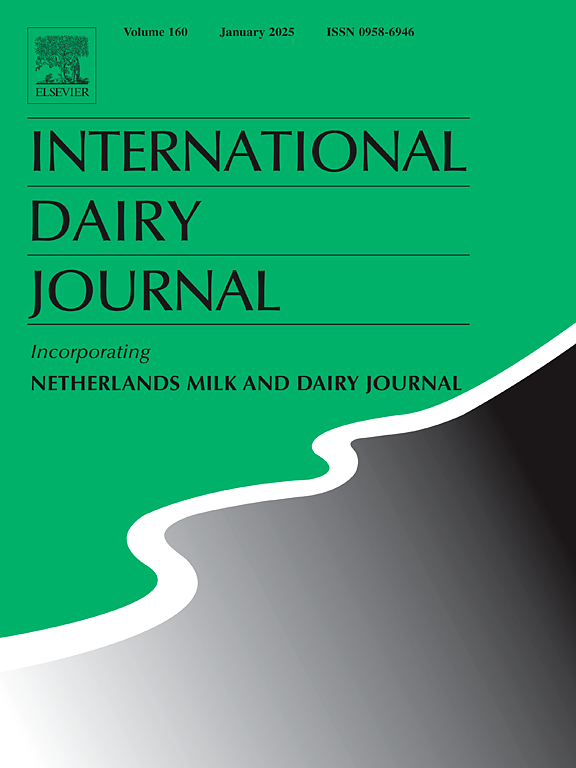Diversity of Pseudomonas spp. isolated from raw milk in Iran: Growth, proteolytic, and lipolytic characteristics
IF 3.4
3区 农林科学
Q2 FOOD SCIENCE & TECHNOLOGY
引用次数: 0
Abstract
This study presented the first diversity of Pseudomonas spp. from raw bulk tank milk in Fars, Iran. Thirty milk samples yielded 31 isolates identified by culture-based and molecular methods (PCR and 16S rDNA sequencing). Most species (61.3 %) belonged to the P. fluorescens subgroup, with P. veronii (29 %) the most frequent. P. aeruginosa detected in 9.7 % of isolates. Strains grew in a wide temperature range (7–42 °C), with 100 % growing at 25 °C and 80.6 % at 7 °C. Proteolytic activity was in 87.1 % of isolates at all temperatures, with 35.5 % retaining strong activity at low temperatures (7–15 °C). The aprX gene was present in 74.2 % and strongly linked to proteolysis. 19.3 % of isolates produced heat-resistant proteases measured by non-protein nitrogen (NPN) in UHT milk. Lipolytic and lecithinase activities were detected in 71 % and 32.3 % of isolates at all temperatures, and 45.2 % and 25.8 % at low temperatures. Combined proteolytic and lipolytic activities were in 58.1 % of isolates. All three enzyme activities were in 25.8 % of isolates, with dominant species of P. fluorescens and P. veronii at 7 °C. These findings highlight a diverse psychrotrophic Pseudomonas population with significant spoilage potential in Iranian raw milk, underscoring the need for improved hygiene and timely milk processing to preserve dairy quality.
从伊朗原料奶中分离的假单胞菌的多样性:生长、蛋白水解和脂解特性
本研究首次从伊朗法尔斯的散装罐奶中发现了假单胞菌的多样性。30份牛奶样品通过培养和分子方法(PCR和16S rDNA测序)鉴定出31株分离物。大多数种(61.3%)属于荧光假单胞菌亚群,以维罗尼假单胞菌(29%)最多。9.7%的分离株检出铜绿假单胞菌。菌株的生长温度范围很宽(7 - 42°C), 25°C的生长率为100%,7°C的生长率为80.6%。在所有温度下,87.1%的分离物具有蛋白水解活性,其中35.5%的分离物在低温(7-15°C)下仍具有很强的活性。74.2%存在aprX基因,与蛋白水解密切相关。在UHT牛奶中,19.3%的分离菌株产生了耐热蛋白酶(NPN)。在所有温度下,分别检测到71%和32.3%的脂溶酶和卵磷脂酶活性,在低温下检测到45.2%和25.8%的卵磷脂酶活性。58.1%的分离菌具有蛋白水解和脂溶活性。在7°C条件下,三种酶的活性均为25.8%,荧光假单胞菌和维罗尼假单胞菌为优势种。这些发现强调了伊朗原料奶中具有显著腐败潜力的多种精神营养假单胞菌种群,强调了改善卫生和及时处理牛奶以保持乳制品质量的必要性。
本文章由计算机程序翻译,如有差异,请以英文原文为准。
求助全文
约1分钟内获得全文
求助全文
来源期刊

International Dairy Journal
工程技术-食品科技
CiteScore
6.50
自引率
9.70%
发文量
200
审稿时长
49 days
期刊介绍:
The International Dairy Journal publishes significant advancements in dairy science and technology in the form of research articles and critical reviews that are of relevance to the broader international dairy community. Within this scope, research on the science and technology of milk and dairy products and the nutritional and health aspects of dairy foods are included; the journal pays particular attention to applied research and its interface with the dairy industry.
The journal''s coverage includes the following, where directly applicable to dairy science and technology:
• Chemistry and physico-chemical properties of milk constituents
• Microbiology, food safety, enzymology, biotechnology
• Processing and engineering
• Emulsion science, food structure, and texture
• Raw material quality and effect on relevant products
• Flavour and off-flavour development
• Technological functionality and applications of dairy ingredients
• Sensory and consumer sciences
• Nutrition and substantiation of human health implications of milk components or dairy products
International Dairy Journal does not publish papers related to milk production, animal health and other aspects of on-farm milk production unless there is a clear relationship to dairy technology, human health or final product quality.
 求助内容:
求助内容: 应助结果提醒方式:
应助结果提醒方式:


